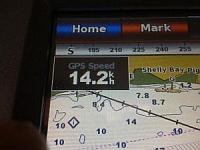 The first word one associates with speed under sail is probably not barge. Nevertheless, Thames River barges are no slackers when the wind is blowing. Recently, the folks at Cambria Trust posted a photo of a GPS screen on restored Thames River barge Cambria that reads 14.2 knots. Apparently the Cambria later reached 15.9 knots. As this was the speed over the bottom we do not know whether she had any help from the current. Nevertheless, that is a very impressive performance. Cambria is the last British registered vessel to carry commercial cargo under sail alone. She did so until 1970. She has since been totally rebuilt and is now back sailing. (See our previous post on the relaunching of the Cambria in March of 2011.)
The first word one associates with speed under sail is probably not barge. Nevertheless, Thames River barges are no slackers when the wind is blowing. Recently, the folks at Cambria Trust posted a photo of a GPS screen on restored Thames River barge Cambria that reads 14.2 knots. Apparently the Cambria later reached 15.9 knots. As this was the speed over the bottom we do not know whether she had any help from the current. Nevertheless, that is a very impressive performance. Cambria is the last British registered vessel to carry commercial cargo under sail alone. She did so until 1970. She has since been totally rebuilt and is now back sailing. (See our previous post on the relaunching of the Cambria in March of 2011.)
Cambria is truly the Cutty Sark of Thames River barges and Thames River barges are probably the clipper ships of coastal working craft. Why? Like the Cutty Sark, Cambria had a long and productive working life. Both have been recently rebuilt and both are, or in the case of the Cutty Sark, were, very fast under sail.
It may sound foolish comparing a barge to a clipper ship. Nevertheless, bear with me. When comparing ship speeds between different ships one needs to take into account the length of the ship. Longer ships can go faster than shorter ships. To compare ships on reasonably equal terms, naval architects and others use the speed-length ratio, which is the speed in knots divided by the square root of the waterline length of the ship. Ships of different sizes traveling at the same speed length ratio are moving at comparable speeds.
Most ships travel at speed-length ratios of around 0.8. Some travel faster. Many travel slower. A modern cruise ship, 850 long on the water would be moving at 23 knots at a speed-length ratio of 0.8, for example. The reason ships generally do no travel faster is that resistance caused by wave-making goes up dramatically at speed-length ratios over 1.0. Many yacht designers talk about a “theoretical maximum hull speed” at a speed-length ratio of 1.34. This is not actually “theoretical” but is a pretty good rule of thumb. Most yachts, except for those which can plane or are very narrow, usually have a hard time going any faster than a speed-length ratio of 1.34.
So why compare a barge to a clipper ship? Clipper ships were very, very fast. The fastest clipper ship ever recorded was the Sovereign of the Seas sailing at 22 knots. This equates to a speed-length ratio of around 1.5. Very impressive. On the other hand, Cambria sailing at 14.2 knots on roughly a 90 foot waterline is also sailing at a speed-length ratio of 1.5! At 15.7 knots, Cambria was sailing at a speed-length ratio of 1.65! For their length, Thames River barges are at least as fast for their length as clipper ships. Very impressive, indeed.
Thanks to David for pointing out the blog post and photo.
